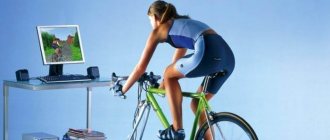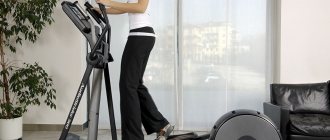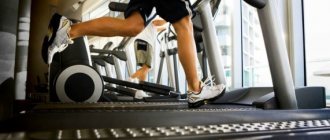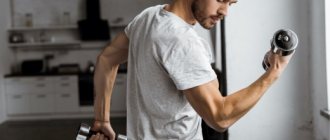Everyone knows how enjoyable and rewarding cycling can be. It strengthens the body and helps burn extra calories. But there is an alternative to cycling, available at home or in the gym. This is an exercise bike, the benefits and harms of which will be discussed below. Classes on it imitate riding a regular bicycle, however, there are differences. Thus, the risk of injury is negligible, while bicycle enthusiasts encounter injuries quite often. In addition, there are some differences in how and what muscles work on an exercise bike and on a regular bicycle. Bicycles are unstable and move relative to space, while stationary exercise bikes stand firmly on the floor. The exercise bike can be used in different modes. Typically, exercise machines are equipped with displays where you can see information about speed, distance covered, calories burned, and so on.
Is it possible to exercise on an exercise bike every day?
A well-known rule of any program aimed at weight loss is that training should be regular. Experts do not consider it advisable to engage actively every day. This may lead to a negative result.
After an active workout, and this is what is needed for weight loss, the muscles need a certain amount of time to rest. By exercising daily, a person essentially deprives his body of the opportunity to recover. As a result, fatigue accumulates, apathy, irritability and sleep problems appear. To prevent this from happening, you need to properly plan your classes, their duration and level of load.
Useful tips
In conclusion, we offer you a couple of useful tips that can be useful for any training program:
- Music. Use uplifting music and other stimuli to help you exercise more actively. If you study at home and turn on your favorite TV show, you are unlikely to be able to set high records.
- Seat lift. If you're using the upright option and want to add extra muscle to your calves and toned butt, raise the saddle higher than the handlebars. To create an imitation of riding a bicycle, the saddle is located at the level of the lower handlebars. To transfer the load to the buttocks and calves, raise the seat higher by 5-7 centimeters. By the way, if you lower the seat, you transfer more load to the quadriceps, but you can achieve more focused work with the calves and gluteal muscles. When you have raised the seat, you should not transfer the load to your arms: you need to continue to leave the main support on your legs, this is the only way you will pump up the muscles in the targeted way. In general, the most difficult position on the machine is when the arms are as low as possible and the hips as high as possible and vice versa. Please note that a comfortable fit is an important parameter for training.
We hope this material will help you achieve your goals! If you have any questions, welcome to the comments.
How long to exercise on an exercise bike: Training schedule
To effectively lose weight, you need to ride an exercise bike 3-4 times a week. This will be enough for the body to rest. The muscles returned to normal.
It is very important to pay attention to how you feel - if the body reacts calmly to exercise every other day - you can set just such a schedule. If, a day after training, the feeling of muscle pain or fatigue has not disappeared, it is better to take a break of 2 days.
An important rule is that even the most intense workout will not bring any benefit if it is followed by a high-calorie meal.
To achieve the desired result, it is important not only to exercise regularly with a gradual increase in load, but also to completely reconsider the principle of nutrition. By eliminating all fatty and floury foods from your diet, you can achieve much more.
Is it possible to exercise if you have other cardiovascular diseases?
Let's look at a few of the most common diseases.
Hypotension (low blood pressure)
The opposite of hypertension is hypotension or hypotension, which is low blood pressure. This disease is also not an obstacle to sports. Moreover, an exercise bike can also be useful here, the main thing is:
- eat some carbohydrates before class (for example, sweets);
- train regularly, without increasing intensity and sudden transitions;
- do not train immediately after waking up, but at least 2-3 hours later, preferably in the evening.
Tachycardia (rapid heartbeat)
A rapid heart rate or tachycardia is also a limitation for active sports training, but physical therapy can also be useful here. Pedaling at a measured pace and regular light exercise with heart rate monitoring are an excellent option for tachycardia.
The situation is often similar with other ailments, but you should always consult a doctor first.
When is the best time to exercise on an exercise bike: morning or evening?
The advantage of morning workouts is that soon after waking up the body is full of strength and energy. But they are “from old stock”.
Studies have shown that during morning workouts, fat deposits are burned much better . After all, it is this reserve that serves as a source of additional energy during significant physical activity.
However, this does not mean that you need to sit on the exercise machine immediately after getting out of bed. It is very important for the body to fully wake up. After sleep, you need to drink a glass of water and perform your usual morning hygiene procedures. And only after that you can start training.
Evening exercise on an exercise bike is less effective for one simple reason. During exercise, the body burns calories received from food during the day. In addition, in the evening a person feels tired - this is quite natural. And he will not be able to exercise as actively as he would like.
Cycling: what is it?
First of all, this is cardio training on special exercise bikes with a sports fit. That is, you do not sit upright, as on a pleasure bike or a regular exercise bike, but position your back almost horizontally, as on a racing bike, due to the fact that the handlebars are not much higher than the saddle.
Next, cycle training is a group lesson led by an instructor. “This is fitness with a good load, it is always “broken” work at intervals, which takes place to the accompaniment of fiery tempo music,” says Daniil Lobakin, cyclist, candidate master of sports, PRO expert Sportmaster PRO. Let's figure out what this means.
The class is usually HIIT (high-intensity interval training), where the average heart rate and calorie burn are quite high. In addition, the lesson includes exercises for the upper body, so at the end you get a complex load on the entire torso, and not just on the legs, as is usually the case with independent cycling training.
How long should you spin an exercise bike per day to lose weight?
The duration of the training is of great importance. If you calmly “pedal” for no more than 15 minutes, you shouldn’t count on results. But, at the same time, you shouldn’t “kill” yourself on the simulator for an hour during your first workout.
To achieve the desired effect, you need to gradually increase the duration and intensity of training.
- It's worth starting with 20 minutes a day.
- After 2-3 lessons, the duration increases by 5 minutes.
- After another 3 classes, you should train for at least half an hour. It is important to share the load.
The “schedule” of the lesson itself could be like this:
- 1/3 of the time is warming up. Exercise at an easy, leisurely pace;
- the next 5 minutes – increase the load;
- another 5 minutes - maximum speed;
- the remaining time is at a free pace.
As your training duration increases, the time intervals may change. Much depends on your health and stamina.
The first few classes, even 5 minutes of intense work, may seem incredibly difficult to some. But after just a few workouts, such a load will be much easier to bear, since the body will gradually begin to get used to it.
Cycling exercises
In addition to the actual pedaling, cycling includes the following exercises:
- Exercises with dumbbells - sitting in the saddle and sometimes even continuing to twist, take dumbbells (there are special stands for them near the machine) and do presses, flyes, flexion-extension of the arms, etc.
- Dance movements - done next to the exercise machine or while pedaling while standing.
- Push-ups from the steering wheel and the floor (including on one arm).
- Rising from the saddle, abduction of the pelvis, abduction of one leg, etc.
Therefore, to the question “Cycle training: what is it?” we can reliably answer that this is a full-fledged aerobic activity that develops endurance and works the muscles of the whole body.
Speed on an exercise bike to burn fat
The speed of rotation of the pedals when exercising on an exercise bike is of great importance. After all, it largely depends on it how many calories will be burned. Here is an approximate calculation of the ratio:
| Speed (km/h) | Number of calories burned |
| 15-17 | 340-360 |
| 18-20 (Medium pace) | 400-420 |
| 21-25 | 480-500 |
| 26-30 | 580-600 |
| Over 30 | 650-670 |
Additional load (some models of simulators allow you to change the degree of incline, increasing the difficulty) help increase the number of calories burned. The same applies to the time of the lesson - the longer you study, the more energy you will spend. Calculate your burned calories using our calculator.
Why is pedaling best?
There are reasons for this:
- a safe stationary device guarantees an insignificant possibility of microtrauma and damage that cannot be avoided when driving (especially if the road is uneven);
- Personal adjustment of an exercise bike, especially a modern exercise bike with a good computer, allows you to pedal smoothly (if you have arthrosis, you should not press the pedals with force).
Also watch the video below:
As you can see, an exercise bike is useful even for various ailments and can be an excellent helper. The main thing is to comply with the appropriate training standards, listen to the instructions of specialists and listen sensitively to your own body.
Load level on an exercise bike for weight loss
Exercise is of great importance for losing weight. A workout that takes place at a calm pace will not bring the desired result. You can change the load level in several ways:
- speed change;
- changing the angle of the “road”;
- use of built-in programs - modern models of simulators have several intensity programs to choose from, each of which gives a specific result.
The ideal solution is a combined load, combining, for example, an increase in load and an increase in speed. However, a lot depends on the degree of a person’s preparedness for the load - working “to the limit” throughout the entire workout can cause sprains, which will delay a new lesson indefinitely.
The increase in load should be proportional to the increase in training duration. The first few classes are held at an easy pace - it is important to understand what level of preparation and endurance you have at the moment.
Regular heart rate monitoring will help you understand this. A rapid heartbeat and a feeling of lack of air indicate that the maximum level has now been reached. This may be followed by a significant deterioration in well-being.
The optimal heart rate during training is 120-140 beats per minute. If it is exceeded, you need to reduce the intensity slightly.
Often, deterioration in well-being during training is associated with non-compliance with the drinking regime. Water is a must! Compliance with the drinking regime allows you to more actively remove products of the breakdown of adipose tissue from the body and restore the natural balance of fluid. Much more effective is a special drink for athletes, for example this:
Types of cycling
In fitness clubs, different types of training are common, which are chosen depending on the level of preparedness of the group:
- Steady riding - pedaling at the same pace, the best choice for a beginner. Upper body exercises are also included.
- Downhill is a simulated descent from a mountain that requires a high pedaling frequency (high cadence) with low resistance. Suitable for both beginners and those who have been practicing for several months.
- Riding while standing - usually at a high cadence. Riding while standing additionally loads the hips and buttocks and works the abs. As a rule, the lesson alternates between sitting and standing intervals.
- Ride tempo can be slow with high resistance and fast with low or optimal resistance. Tempo intervals are alternated to provide a varied challenge to the muscles and cardiovascular system.
- Changing the inclination of the torso - on a sports bike you can either sit higher, holding the upper part of the handlebar, or, conversely, almost upside down, placing your hands on the “lounger” placed forward. Alternating the position of the torso in the bike diversifies the load and reduces the back discomfort that you may encounter if you are not used to it.
- Simulated hill climbing is the hardest type of cycling, which can be performed either with slow pedaling and a heavy load, or with a high cadence and low resistance. Recommended for physically fit people; for those with less endurance it is given at short intervals.
Exercising on an empty stomach for weight loss
Exercising before meals forces the body to use internal resources as efficiently as possible. When a person is hungry or has just woken up, his body has a fairly low level of glycogen (a reserve reserve of carbohydrates accumulated in the liver and muscles). During training, it is the one that is burned first.
And then the body needs additional energy - and it gets it by starting to break down subcutaneous fat. This is why training “on an empty stomach” is considered the most effective.











